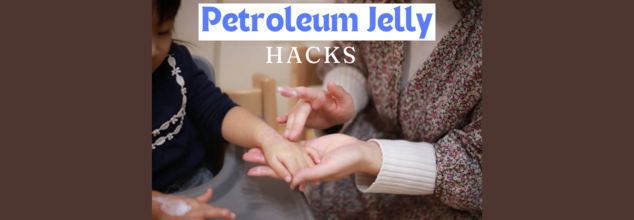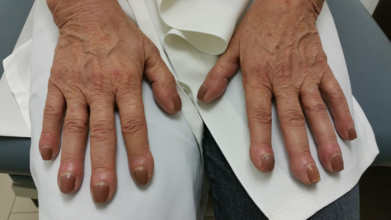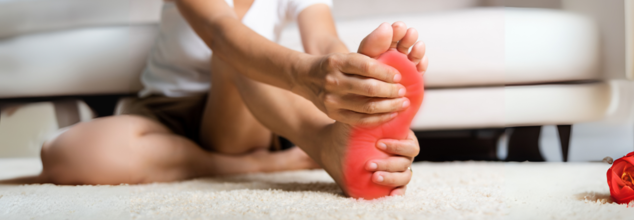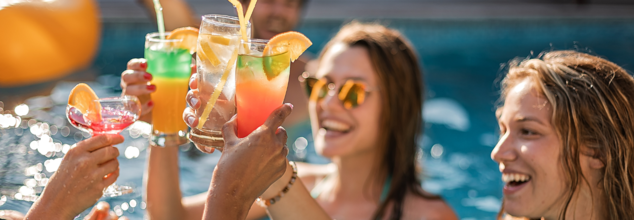- Health Conditions A-Z
- Health & Wellness
- Nutrition
- Fitness
- Health News
- Ayurveda
- Videos
- Medicine A-Z
- Parenting
- Web Stories
8 Game-Changing Petroleum Jelly Hacks For Your Skincare Routine

Growing up, I often watched my grandmother reach for that iconic blue jar of petroleum jelly, known to many as Vaseline, whenever she encountered a minor skin issue. From chapped lips to dry elbows, she swore by it. Over the years, I’ve come to appreciate this versatile product myself, discovering that its uses go far beyond what I ever imagined.
Petroleum jelly is a classic, affordable product that belongs in every household. Whether you're looking to solve a beauty dilemma or address a minor skin concern, this humble jar can offer a solution. With these simple hacks, you can maximize the benefits of petroleum jelly and experience its enduring versatility for yourself.
Petroleum Jelly Hacks You Did Not Know About
Petroleum jelly is often overlooked in the vast world of beauty and skincare products, yet it remains a reliable, multipurpose item that offers numerous benefits. It's not just for moisturizing; this simple product can be a game-changer in many unexpected ways. Below are some of the most effective and surprising petroleum jelly hacks you can easily incorporate into your beauty regimen.1. Soothe Dry Elbows and Knees
If you struggle with dry, rough elbows and knees, petroleum jelly can provide instant relief. Apply a generous layer to these areas before bed and cover them with soft fabric (like old socks with the toes cut off) to lock in moisture. By morning, your skin will feel significantly softer and smoother.
2. Protective Barrier for Minor Cuts and Scrapes
Petroleum jelly is excellent for minor cuts and scrapes, acting as a protective barrier that keeps bacteria out while promoting faster healing. After cleaning a small wound, apply a thin layer of petroleum jelly to prevent it from drying out and forming a scab. This can help reduce the risk of scarring.
3. Tame Unruly Brows
Struggling with unruly eyebrows or hair flyaways? A small dab of petroleum jelly can work wonders. Gently smooth it over your brows to keep them in place or use it to tame any pesky flyaways. It provides a subtle hold without the stiffness of hairspray or gel.
4. Fragrance's Longevity
One surprising hack is using petroleum jelly to extend the life of your favorite perfume. Apply a small amount to your pulse points—wrists, neck, behind the ears—before spritzing your fragrance. The jelly helps to lock in the scent, allowing it to linger on your skin longer throughout the day.
5. DIY Lip Scrub
For soft, kissable lips, mix petroleum jelly with a bit of sugar to create an effective DIY lip scrub. Gently massage it onto your lips in circular motions to exfoliate dead skin cells, then wipe away the residue. Your lips will be left feeling smooth and hydrated.
6. Prevent Chafing
If you’re prone to chafing, especially during workouts or in hot weather, petroleum jelly can be your best friend. Apply it to areas where your skin rubs together, such as thighs or underarms, to reduce friction and prevent irritation.
7. Nail and Cuticle Care
Dry cuticles and brittle nails can benefit from regular applications of petroleum jelly. Massage it into your nails and cuticles before bed to keep them moisturized and promote healthy nail growth. This simple step can help prevent painful hangnails and keep your manicure looking fresh.
8. Makeup Remover
Out of makeup remover? Petroleum jelly can effectively dissolve even the most stubborn makeup, including waterproof mascara. Apply it to your eyelids and lashes, then gently wipe it away with a soft cloth or cotton pad. It’s a gentle and moisturizing alternative that won’t dry out your skin.
What Is Nail Clubbing, and Could It Be a Sign of a Serious Disease?

It usually begins subtly; your fingertips gradually thicken, your nails start to curve more than usual, and the angle between the nail and the cuticle becomes more pronounced. This is known as nail clubbing, a physical sign that can point to underlying health issues. Often painless and subtle at first, clubbing is not a condition by itself, but rather a potential indicator that something more serious may be going on inside the body.
If you press your nail and the skin just beneath it feels a bit spongy or springy, that’s another telltale sign.
But why should you care about this?
Nail clubbing is not a standalone condition. It is more like your body is throwing a sign for you to look deeper for something that might be wrong. Often, it is the lungs or heart sending the signal. In fact, clubbing is most commonly linked to low levels of oxygen in the blood over a long period. And that can point to some pretty serious stuff.
Here is a breakdown of the usual causes:
Lung conditions: Clubbing is seen in chronic lung diseases like lung cancer, pulmonary fibrosis, or bronchiectasis. Even long-term infections like tuberculosis or lung abscesses can trigger it. Basically, anything that messes with how oxygen moves from your lungs into your blood can potentially lead to clubbing.
Heart problems: Certain congenital heart defects (especially ones that cause low blood oxygen) can also show up through your fingertips. Endocarditis, an infection of the heart’s inner lining, is another silent cause.
Gastrointestinal diseases: Yes, your gut might have a say too. Clubbing is sometimes associated with conditions like Crohn’s disease, ulcerative colitis, or severe liver disease. Not exactly the first thing you would expect from nail changes, but there it is.
Other rarer causes: Graves’ disease (a thyroid condition) and some inherited genetic disorders can also lead to clubbing. But again, these are outliers.
But why does it affect nails?
Chronic low oxygen levels may lead to dilation of blood vessels in the fingertips, increasing blood flow and tissue build-up. But no one fully understands the exact mechanism yet. It is still a bit of a medical mystery.
What should you do if your nails look suspiciously clubbed?
Do not panic, but do not ignore it either. It is not something to diagnose with a selfie and a Google search. A doctor will likely check your oxygen levels, get a chest X-ray or scan, and run other tests depending on your symptoms. The earlier you find the underlying issue, the better.
And while nail clubbing is not always bad, it can be idiopathic, meaning no known cause and harmless. It is still worth getting checked.
Your Ethnicity May Be Putting You At Higher Risk For This Major Nerve Disorder

(Credit-Canva)
There are many genetic disorders, or diseases that only occur in people of a certain ethnicity. MedlinePlus explains that these diseases occur among people whose ancestry lies in a specific geographical location. This is because people in the same ethnic group often share versions of genes which were passed down by a common ancestor. Another such diseases have been found in a new study, according to a news release by the American Academy of Neurology.
A new study has found something puzzling: Hispanic people are more likely to develop nerve damage called peripheral neuropathy than white people, and we don't know exactly why.
Even after looking at well-known health issues, lifestyle choices, and social situations, Hispanic individuals were still 32% more likely to have this condition. Experts believe there might be some unknown social factors at play that we need to discover. Finding these missing pieces is crucial for future research.
What is Peripheral Neuropathy?
Peripheral neuropathy happens when the nerves outside your brain and spinal cord get damaged. This often leads to weakness, numbness, and pain, most commonly in the hands and feet.
It's been observed that in the United States, Hispanic and Black individuals tend to have higher rates of peripheral neuropathy than white people, but the exact reasons for these differences aren't yet clear.
What the Study Looked At
Researchers examined health information from over 8,000 people. About 13% of them had peripheral neuropathy. The study participants' average age was 61. The research team considered many factors that can increase the risk of neuropathy, including:
- Age and gender
- Health conditions like waist size, blood pressure, blood sugar, and cholesterol levels
- Daily habits such as how much they exercise and what they eat
- Social aspects like whether they had enough food, their household income, and if they had health insurance
The study generally found that people with neuropathy were more likely to have diabetes, high blood pressure, a larger waist, and lower income. They also tended to be less physically active.
Unexplained Differences Remain
Generally, the study found that individuals with neuropathy tended to have diabetes, high blood pressure, larger waist circumference, and lower incomes. They also reported being less physically active.
When researchers initially adjusted only for age and sex, both Hispanic and Black individuals showed higher odds of peripheral neuropathy compared to white individuals. However, after accounting for all other risk factors, the odds for Black individuals became similar to those of white people. This was not the case for Hispanic individuals, who continued to show an increased risk of peripheral neuropathy even after all other known factors were considered.
Role of Social Factors
The study highlighted the significant influence of known social factors on peripheral neuropathy risk among Hispanic individuals. For instance, being uninsured increased their risk by 56%, and experiencing food insecurity raised it by 48%.
Given the growing percentage of Hispanic individuals in the United States, the researchers concluded that future observational studies should prioritize identifying the unmeasured risk factors contributing to peripheral neuropathy in this population
Summer Drinking Poses A Health Risk You May Not Be Aware Of: Why Heat And Alcohol Don't Mix Well?

(Credit-Canva)
Drinking is a social activity that people enjoy, although it is understood that everyone should drink in moderation, we all tend to go a little overboard sometimes. These tend to happen, especially during vacations and holidays however, even during vacations one must not forget to prioritize one's health and well-being. The National Institute on Alcohol Abuse and Alcoholism (NIAAA) warns that excessive alcohol consumption in the summer heat can be deadly with 1 in 6 Americans being a binge drinker, it's crucial to prioritize safety.
The NIAAA urges everyone to "think before you drink", in order to ensure your safety and the well-being of your loved ones, avoid consuming alcohol when piloting a boat, driving a car, exploring the wilderness, or engaging in swimming or surfing. The NIAAA also notes that drinking more than usual can lead to higher blood alcohol concentrations, especially if you're consuming more alcohol than you're accustomed to at home. The dangers of drinking alcohol while engaging in summer activities are significant:
Drowning Deaths
A shocking 31% of U.S. drowning fatalities involve individuals with blood alcohol levels of 0.10% or higher.
Boating Accidents
A boater with a blood alcohol content (BAC) of 0.08% – the legal limit for intoxication in all 50 states – is 14 times more likely to be killed in a boating accident than a sober individual.
Traffic Fatalities
Drunken driving contributes to one-third of all traffic fatalities on U.S. highways. Summer vacations, with their unfamiliar routes, potential for towing, and excited passengers, amplify these risks.
Why Heat And Alcohol Don't Mix Well?
A 2005 study published in the Alcohol journal, researchers looked at how alcohol changes your body's ability to control its temperature and how hot or cold you feel when it's a bit warm outside.
They found that just 10 minutes after drinking alcohol, participants started sweating more from their chests and had increased blood flow to their skin compared to when they drank water.
About 20 minutes after they started sweating more, their internal body temperature began to drop. Eventually, it became 0.3 degrees Celsius (about 0.5 degrees Fahrenheit) lower than when they drank water.
The researchers found that how your body handles heat in a couple of ways. It makes your body cool down automatically through sweating and increasing blood flow to your skin. But it also makes you feel hotter, which would make you want to cool down yourself.
These results suggest that when your body temperature drops after drinking alcohol, it's not just because blood rushes to your skin (which alcohol is known to do). Instead, it seems like alcohol actually resets your body's internal thermostat to a lower temperature. This causes all your body's cooling systems, including sweating and feeling hot, to work together to bring your temperature down.
Safety Issues You May Face With Alcohol In Summer
Travel and Alcohol
When you're away on vacation, it's easy to let loose, and for some, that might mean drinking more than usual. This can lead to higher blood alcohol concentrations (BACs) and an increased risk of accidents and injuries, especially if you're consuming stronger drinks than you're used to. Alcohol can also worsen travel-related health issues like motion sickness and heat-related illness, and it can even negatively interact with medications you might take for travel.
Dehydration
Whether you're exploring the wilderness or just on a road trip, the combination of heat and alcohol can spell trouble. Hot summer days cause your body to lose fluids through perspiration, while alcohol acts as a diuretic, increasing fluid loss through urination. Together, these effects can quickly lead to dangerous dehydration or even heat stroke.
Skin Protection
Sunburns can quickly ruin a summer vacation. Interestingly, studies suggest that people who drink alcohol while out in the sun are less likely to apply sunscreen. Furthermore, research indicates that alcohol might even reduce the amount of sun exposure needed to get a burn. Since repeated sunburns significantly increase your risk of skin cancer, it's vital to slather on that sunscreen generously, regardless of whether you're drinking, to ensure maximum summer fun and safety.
Stay Safe and Healthy This Summer
Being smart about your choices this summer starts with thinking before you drink. To keep yourself and your loved ones safe, avoid alcohol when you're piloting a boat, driving a car, exploring nature, or swimming and surfing.
Provide Food: Offer a variety of healthy foods and snacks. Eating can slow down alcohol absorption, reducing the peak BAC by about one-third, and can also help prevent stomach irritation the next day.
Offer Alcohol-Free Options: Have plenty of water, juices, and sparkling sodas available. These not only combat dehydration but can also slow down alcohol absorption and reduce peak alcohol concentration in the blood, giving your guests excellent alternatives.
Ensure Safe Rides Home: Always help your guests get home safely. Encourage the use of designated drivers, ride-hailing services, or taxis. No one who has consumed alcohol should ever get behind the wheel.
© 2024 Bennett, Coleman & Company Limited

